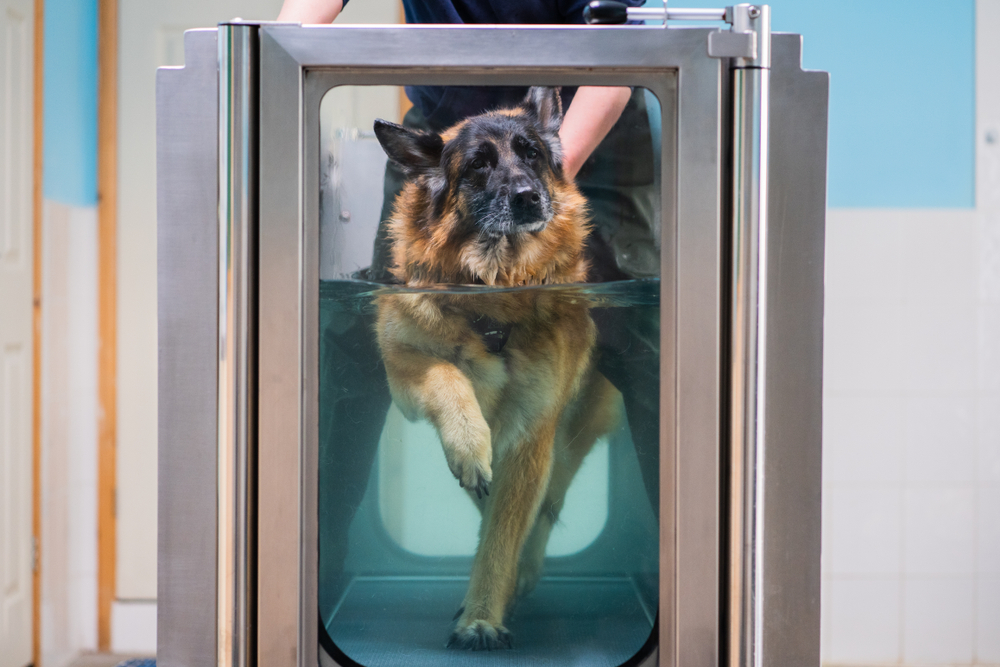Hip dysplasia, along with other painful orthopedic conditions, is often thought of as an older dog’s problem, but this anatomical abnormality typically develops in puppies and then causes osteoarthritis as the dog advances in age. If you own a large- or giant-breed pooch, brushing up on your hip dysplasia knowledge can save them from a world of pain and impaired mobility. Read on for more from our Star of Texas Veterinary Hospital team about how hip dysplasia develops, how to spot it in your dog, and how to manage their discomfort.
What is hip dysplasia in dogs?
Hip dysplasia is an orthopedic condition caused by an improperly fitting hip joint. Hip joints are ball-and-socket joints, with the femoral head functioning as the ball, and the acetabulum cupping the femoral head in the socket. In dogs with hip dysplasia, the ball and socket do not fit together correctly, and rub or grind against each other instead of gliding smoothly. Over time, joint cartilage degrades, the bones become jagged, and pain and decreased mobility result.
Are certain dogs at an increased risk for hip dysplasia?
Any dog has the potential to develop hip dysplasia, but dogs who fall into certain categories are at an increased risk. If your dog checks any of the following boxes, they are more likely to develop hip dysplasia:
- Poor genetics
- Large or giant breed (e.g., German shepherd, Newfoundland, Great Dane, Labrador retriever)
- Rapid growth
- Excessive weight
- Unbalanced nutrition
- Improper exercise
While hip dysplasia is a hereditary condition, outside factors can exacerbate the issue. Obesity, intense exercise during puppyhood, and lack of a balanced diet while growing can contribute to orthopedic problems.
What signs will I see if my dog has hip dysplasia?
Hip dysplasia can range greatly in severity, and associated signs may not become noticeable until a dog has developed osteoarthritis. Puppies who are affected by the disease can show signs much earlier and develop issues corresponding to their degree of hip laxity.
If your dog has hip dysplasia, you may notice any of the following problems:
- Reluctance to rise, jump, or use stairs
- Disinterest in play and exercise
- Muscle mass loss in the hind end
- Decreased range of motion
- Irritability when petted over the hips
- Lameness
- Bunny-hopping gait
- Weight shift to the front legs
- Pain
Without treatment, your pet’s clinical signs will worsen over time as osteoarthritis sets in.
How will my veterinarian diagnose hip dysplasia in my dog?
If your dog’s hip dysplasia is severe, a visual exam likely will be enough to suggest the disease and guide diagnostic testing. A history of problems you have noticed at home can rule out similar conditions, while a thorough exam can discover hip laxity, grinding bone, pain, or a reduced range of motion. Simply watching your dog walk and sit in the exam room can provide key clues that indicate hip dysplasia is present.
To confirm a hip dysplasia diagnosis, specialized X-rays are taken. Light sedation or general anesthesia is required to take the proper images because stretching out the affected limbs typically causes discomfort.
What treatment options are available for dogs with hip dysplasia?

Many management and treatment options are available to minimize discomfort, preserve muscle mass and joint cartilage, and improve mobility. Treatment can range from medical management and lifestyle changes, to advanced surgical procedures to reshape the hip joint.
Treatment options for your dog’s hip dysplasia may include:
- Medicines — Numerous medications can be administered to provide relief from pain and inflammation, while stimulating joint fluid production and cartilage regeneration and preservation.
- Diet changes — A switch to a diet and supplements rich in omega-3 fatty acids, glucosamine, chondroitin, and other joint-preserving ingredients can boost joint health while reducing inflammation and helping your dog maintain a healthy weight.
- Alternative therapies — Physical rehabilitation, range-of-motion exercises, hydrotherapy, laser therapy, acupuncture, and chiropractic care can be used as complementary treatments to medications or surgery to minimize pain and inflammation.
- Surgery — Certain surgeries can be performed on puppies as young as 10 weeks old to help shape the hip joint as the puppy grows, while some surgeries replace the hip joint or remove the ball portion of the joint.
If you are planning on welcoming a large-breed puppy into your family, or you have an adult dog who is showing impaired mobility and discomfort, schedule an orthopedic evaluation. Give our Star of Texas Veterinary Hospital team a call to set up your pet’s appointment to help preserve their joint function and comfort.





